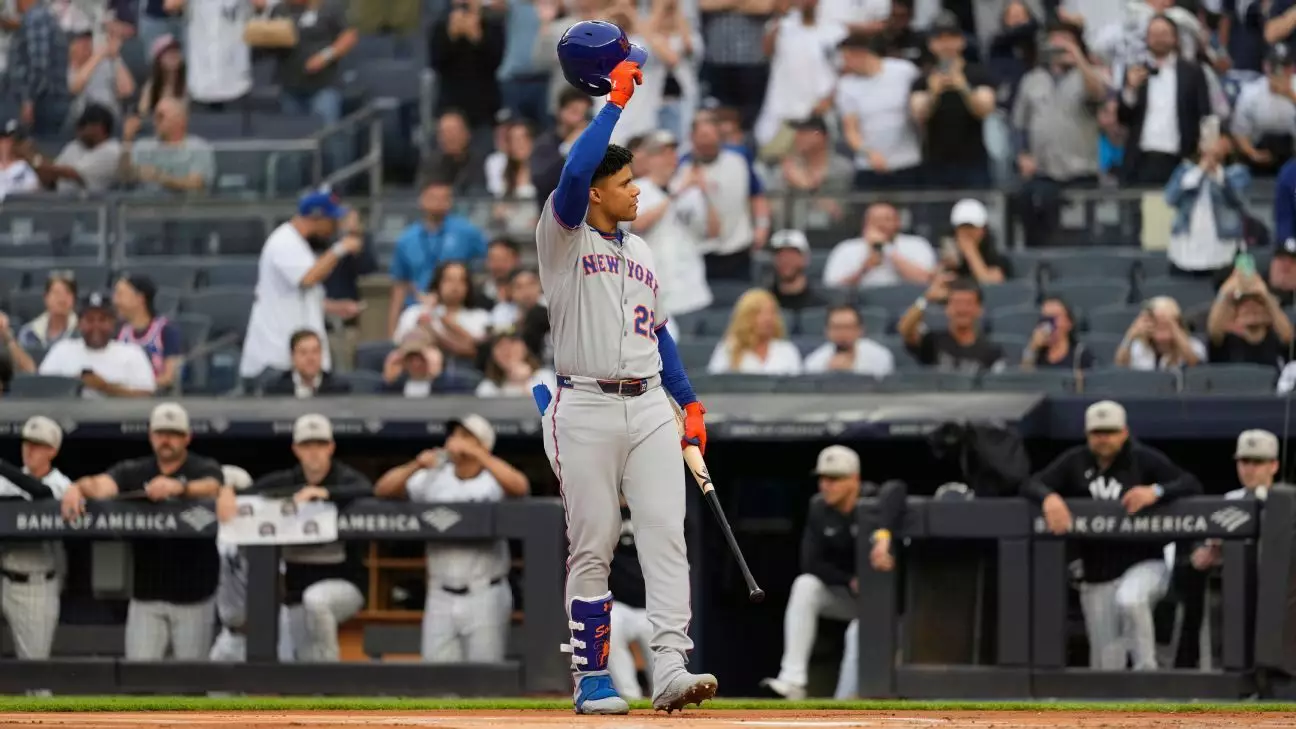Juan Soto’s much-anticipated return to Yankee Stadium donned in a Mets uniform was a spectacle of emotion—a mixture of hostility and nostalgia. It was not merely a walk back onto a field; it symbolized the deeper narratives woven through the fabric of professional sports, where loyalty and choices intertwine. Scorned fans voiced their displeasure with resounding boos and chants, demonstrating just how passionately invested they are in their team and players. Soto, now clad in the rival team’s colors, sat, cool and collected, as the atmosphere buzzed with frustration. “I was ready for it,” he admitted post-game, embodying a sense of resolve that is often challenging to maintain in such charged circumstances.
The desire of Yankees fans to express their disappointment was palpable, yet Soto’s reaction showcased his awareness of the emotional dynamics at play. He noted, “They’re really passionate fans and they’re a little hurt.” This understanding reveals his emotional intelligence—a crucial asset that extends beyond the diamond. Interaction with fans, whether synchronized in applause or dissonance in jeers, can define an athlete’s identity in the public eye.
The Boisterous Chorus
Throughout the game, the unmistakable sound waves of lament and frustration rolled toward Soto like waves crashing against a sturdy hull. The crowd was relentless, their chants laden with explicit emotion, a testament to their unmet expectations. There was a unique irony in hearing the same fanbase that once rallied for Soto and cheered his feats now chanting in anger at his perceived betrayal. Herein lies the intricate relationship between fan loyalty and player autonomy; it’s a precarious balance that many athletes must navigate daily.
Yet Soto, with the audacity and playfulness he often demonstrates on the field, decided to engage with the crowd rather than shy away from the negativity. His decision to tip his helmet and acknowledge the overwhelming hostility with a smile transformed the narrative from one of simple aversion to a more complex interaction. “We were just joking in the dugout that I should do it, and I just did it,” Soto remarked. This move not only defused some of the tension but also transformed an atmosphere ripe for conflict into a moment of levity.
Performance Beyond the Prowess
Physically, the game for Soto may not have been a triumph. Although he managed to walk in his first three trips to the plate and contributed to his team’s scoreboard, his overall performance fell below the expected caliber set for a player with his contract—a staggering 15-year deal worth $765 million. Yet, it’s essential to recognize that his ability to maintain focus amidst external pressures was, in itself, a testament to his resilience. Soto was well aware that the fans’ sentiments dominated the narrative, yet he sought to remain anchored in the game itself, stating, “I don’t focus at all on fans. We got to focus on the game and be a professional.”
This dichotomy must be celebrated—a young man navigating the dual pressures of high expectations and emotional chaos. His somewhat subdued statistics—ending with a .252 batting average and .845 OPS—speak volumes about the adjustment required when switching teams. The compassionate words of Mets manager Carlos Mendoza reflect an inherent belief in Soto’s potential to rise above this temporary setback, reminding us that even the brightest stars need time to acclimate to a new environment.
The Unseen Heroes of the Game
Defensively, the evening proved to be a mixed bag for Soto. Notably, a missed throw during a pivotal moment of the game accentuated the scrutiny that awaits each misstep made under the spotlight. Even while executing a basic play, the stakes behind his decisions felt exaggerated by the intense crowd response. Each choice is magnified when the stakes are high, and Soto’s every move was met with a resounding cheer or chorus of disapproval—a sharp contrast that any athlete can readily attest to.
This reflection dives deeper into the ethics of sports fandom, where joy, disappointment, and everything in between collide. Soto’s interactions with fans, whether enraptured or disgruntled, indicate that he embodies the complexities of being a professional athlete in a rapidly evolving landscape of personal and corporate loyalty. As he caught a fly ball toward the end of the game and tossed it over his shoulder into the stands, the mix of actions—the cheers, the jeers, the undeniable spectacle—captured the essence of sports herself: drama, rivalry, and a heart for the game.
In a post-game world rife with analysis and emotional reflection, Soto’s return painted a vivid canvas of the current state of sports, highlighting themes of identity, resilience, and the indelible human spirit that persists within the game.

